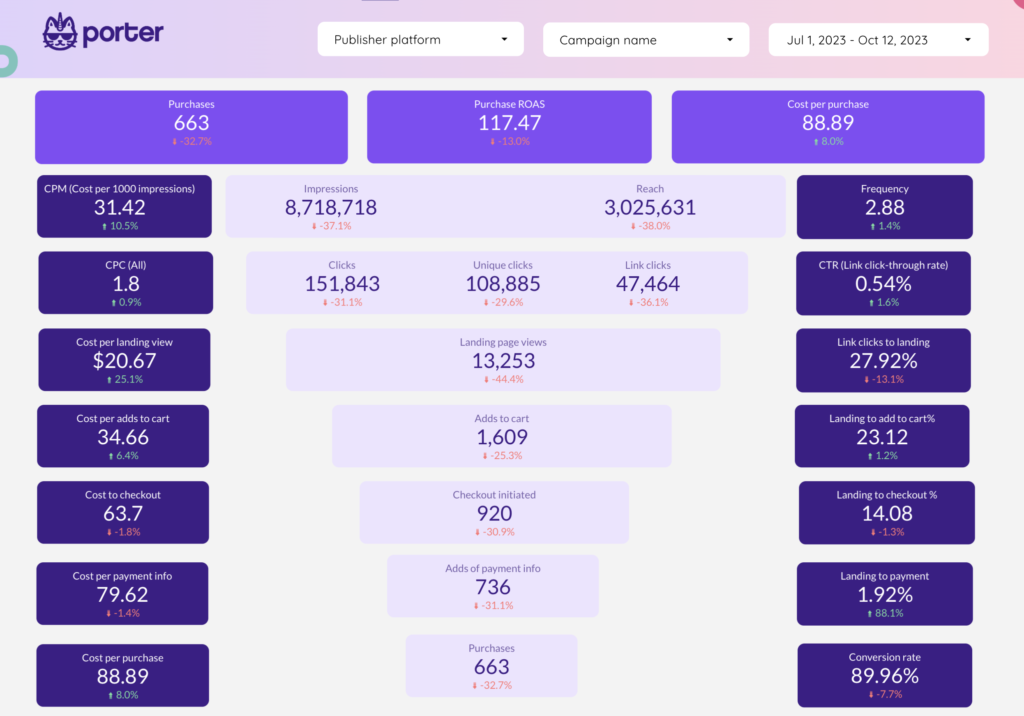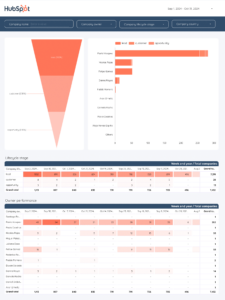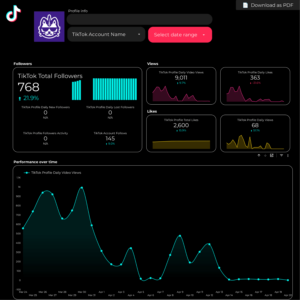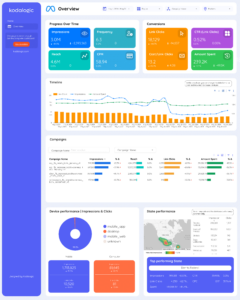To connect Mailchimp to Google Looker Studio (formerly Data Studio), go to Create report (or to the Looker Studio community connectors gallery), choose the Mailchimp integration by Porter Metrics, connect your Google account, connect your Mailchimp accounts, choose your accounts, see the list of fields available, and generate a default report template to monitor your campaigns performance and automate your marketing reports.
By the end of the tutorial, you’ll know:
- 3 free and paid ways to connect Mailchimp to Looker Studio
- Customize your Mailchimp reports
- Available Mailchimp metrics and dimensions
- Custom Mailchimp metrics and dimensions
- Free Mailchimp Report templates for Google Looker Studio
Free and paid ways to connect Mailchimp to Looker Studio
You can connect Mailchimp to Looker Studio through a connector (suggested for this tutorial), or importing data first to a Google Sheet automatically or manually.
As an additional resource, learn to connect any data to Looker Studio, or, if you present any problems during the setup, go to our troubleshooting guide.
Mailchimp connector for Looker Studio
The advantage of using a direct connector is that you can create charts by freely combining metrics and dimensions, without managing queries or Sheets in between, making it faster and easier to build reports.
In a nutshell, follow these steps when using a Mailchimp connector for Looker Studio.
Go to the Porter Metrics onboarding or the Google Looker Studio connectors gallery and choose the Mailchimp connector (by Porter).
Connect the same Google account you’re using on Google Looker Studio.
Click on Authorize to connect Porter and Facebook.
Connect the Mailchimp account with access to your ad accounts. It doesn’t need to be the same one as the one from Google.
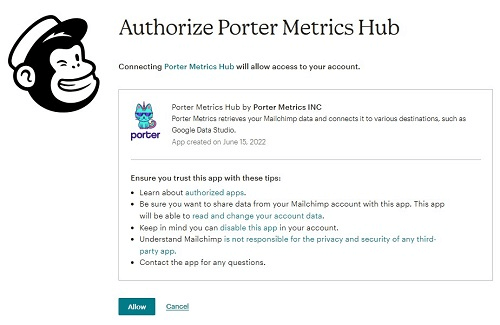
Optionally, connect other Mailchimp accounts to connect Mailchimp accounts your profile doesn’t have permissions for.

Close the authentication popup and go back to Looker Studio.
Choose one or more Mailchimp accounts to use in your reports, and click on Connect.
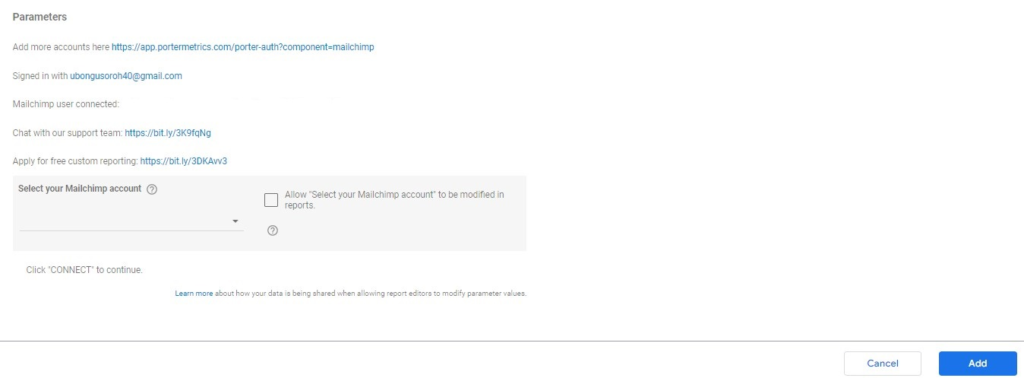
See the fields and go to Create report.
Download our free Mailchimp report template for Looker Studio, and start a 14-day free trial:
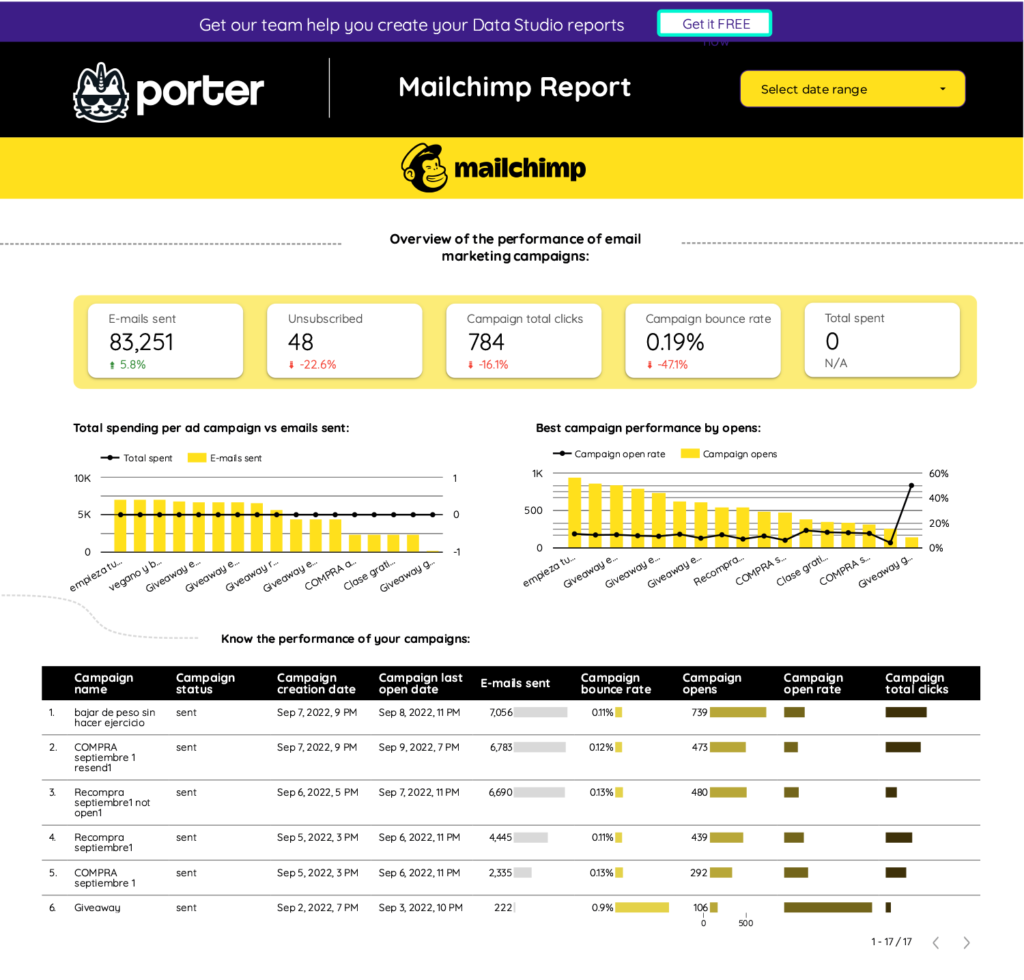
Importing Mailchimp data on Google Sheets
The advantage of using Google Sheets as integration is instant load time when querying small amounts of data, and guaranteed stability, as you’re using Google’s native integrations.
With Sheets, also, you can edit your data. For instance, you could set goals, agency markups or commissions.
As a downside, connecting to Google Sheets first hinders the use of templates and removes data granularity (i.e. freely combining metrics and dimensions when creating charts).
Use the Porter Metrics Google Sheets add-on to automatically import your Mailchimp data on a Google Sheet to later connect that Google Sheet to a Looker Studio report.
Uploading a CSV file
As a free option, manually download your Mailchimp data as a CSV file and import it on a Google Sheet, but:
- Data won’t refresh and update automatically
- Up to100 uploads
- Max 100MB per CSV
- All CSV files structure must be identical
Customize your Mailchimp reports
To continue with the report setup, you can add a new page on the report template just downloaded, or create a new report from scratch, and go to the Edit view.
If you opt to create a new report, here’s how to connect again your data on Looker Studio.
Adding charts
Add scorecards, time series, tables, pie charts, and more chart types to visualize your data.
Scorecards
Scorecards are the most simple way to display your data, by only showing a metric.
Go to Insert, choose a scorecard, and paste it in the canvas.
We’ll use Subscribes as the metric that corresponds to the number of contacts on your lists on Mailchimp.
Create 2 more scorecards by repeating the process or copy-pasting the original scorecard.
Optionally, use List total members, unsubscribes, Open rate, and List total contacts, or +100 fields.
Time series
Time series charts are useful to visualize trends over time.
Go to Insert – Time series.
Use date as date dimension. Use Subscribes as the metric.
Optionally, use other date dimensions like month, week, day of week.
Tables
Tables are the most flexible and complete way to visualize data, letting you add as many metrics and dimensions as you want.
Go to Insert – Table.
Use Campaign name and Campaign status as dimensions; Use emails sent, bounce rate, opens, open rates, and clicks as the metrics to map your email marketing funnel.
Bar charts, pie charts, and maps
Both bar charts and pie charts let you visualize your data by breakdowns. Bar charts are better for cardinal and ordinal data; pie charts are better for nominal data.
Go to Insert – Pie chart.
- For the bar chart, use Member status as the dimension.
- For the pie chart, use Member email address as the dimension.
- For the map, use the Member country as the geo dimension.
As metrics use member-level metrics such as member open rates, member opens, or star rating.
Comparisons
Add goals, reference lines, or conditional formats to compare your data and add context.
Comparison date range
Select the scorecards and set Previous Period as the comparison date range.
Reference lines
Select the time series Go to Style – Add a Reference line, choose Metric as type, and Average, as aggregation.
Conditional formatting
Select the time series Go to Style – Conditional formatting, choose Color scale and any metric.
Adding controls
Use dropdowns, search bars, data range controls, or parameters to make your reports interactive by applying filters. Learn more about controls.
Date range controls
Go to Add a control – Dropdown. Choose Date range control to visualize your marketing data daily, weekly, monthly, etc.
Dropdowns
Go to Add a control – Dropdown. Choose Campaign name or Member email address as the dimension.
Design
To influence your team or clients, design and white-label your marketing dashboards. Also, follow our recommendations on designing marketing reports.
Shapes
Use rectangles or circles to draw sections or headers. Right-click the rectangle – Order – Send to back.
Text
Use text to add headers, chart titles, or complementary analysis or comments to your charts.
Go to Text on the Looker Studio menu and paste it in the header of the report. Customize the font family and size.
Colors
Customize the colors of every single chart.
Select the scorecard and go to Style. Change the value size, colors, backgrounds, and borders.
Optionally, select and copy a chart, and copy-paste its style in another chart with right-click – paste special – Paste style only.
Logo
Change the current logo or add your own by choosing Image and uploading a PNG file.
Theme and layout
Change your report’s canvas size, navigation menu, background colors, and default charts’ style.
To customize the theme, go to Theme and Layout – Theme. Choose one of the default templates or customize it.
To customize the layout, go to Theme and Layout – Layout.
- View mode: set the header visibility to Initially hidden; set the navigation type to the left; and set the mode to fit to width and remove the margin to make your report mobile-friendly.
- Canvas size: we’d suggest 1024×768 for a slide view, or 900×1200 for a vertical view.
Navigation
You can create multiple pages for your report, divide them by sections, and add icons.
Go to Page – New page. On Page settings, you can do any customization at a page level, without impacting the whole report.
Share
Share your Google Looker Studio reports with an audience through permissions, links, embeds, PDF, or email schedules.
Permissions
Grant editor or viewer permissions to users with Google accounts within or outside your company.
Schedule delivery
To schedule an automatic report delivery, go to Share – Schedule delivery.
Set the subject, recipients, pages, filters, start date, and frequency to send your reports via email.
Download PDF
Download a PDF version of your reports and, optionally, exclude pages.
We encourage you to take our Google Looker Studio tutorial for marketers and learn to present your marketing reports.
Mailchimp metrics and dimensions
As reference, see the Mailchimp fields list and suggestions for choosing Mailchimp KPIs.
The Mailchimp connector for Google Looker Studio offers all the +600 metrics and dimensions on the Mailchimp, including:
Fields
Time
Time fields let break down the data daily, weekly, monthly, etc., for different types of analysis. The fields, generic across any integrations, include:
- Date
- Week of year
- Day of week
- Hour of the day
- Month and Year
Lists
Also referred to as audiences, they are the way to group emails for better segmentation and management.
Lists refer to the email lists that users can create on their Mailchimp account to manage their contacts and the emails they will be sent.
For instance, Porter has an email list for Shopify users and another for Facebook Ads users.
As such, we allow Porter users to create tables or bar charts from displaying Mailchimp lists, including these fields:
- List ID
- List name
- List signup form link. This refers to the form that people submit to join the list. Mailchimp brings a short and extended version of this URL
- List rating: Mailchimp gives 1-5 stars based on the quality it calculates for the list. Quality refers to the quality of emails this list has.
- Notification email for subscribes
- Notification email for unsubscribes
- Permission reminder
- List creation date
- List last subscriber date
- List last unsubscribed date
- List abuse reports: refers to the number of list members reporting spam
- List abuse report details
Lists insights
Mailchimp allows users to report daily aggregated data for these metrics:
- List signups
- List unsubscribes
- List emails sent
- List opens
- List clicks
- List open rate: opens/emails sent
- List Click-Through rate (CTR): clicks/opens
- List-unsubscribe rate: unsubscribes/total subscribers
- List growth: shows daily how many list members a list has
- List opt-ins
- List imports
- List removes
- List subscribed members
- List unsubscribed members
- List reconfirmed members
- List cleaned members
- List pending members
- List deleted members
- List members with transactional emails
List all-time totals
- List total campaigns
- List total members
- List total members since the last send
- List cleaned members
- List unsubscribed members
- List all-time open rate
- List all-time click rate
- List average subscriptions per month
- List average unsubscriptions per month
- List target growth rate
List members
List members refer to the emails (people) that belong to a specific list. Metrics that can be tracked are:
- Member email
- Member ID
- Member status (subscribed, unsubscribed, or bounced member).
- Member name
- Member first name
- Member last name
- Member custom fields (add other dimensions that Mailchimp users may want to add to their members)
- Member timezone
- Member country
- Member signup date
- Member opt-in date
- Member unsubscribe date
- Member unsubscribe reason
- Member last change date
- Member open rate (opens/sends)
- Member emails sent
- Member emails opened
- Member clicks
- Member average click-through rate
Campaigns
Campaigns refer to the emails we send to our audiences in bulk. An example of a campaign can be weekly newsletters or product updates.
Campaign details
- Campaign ID
- Campaign name
- Campaign type
- Campaign folder ID
- Campaign folder name
- Campaign status
- Campaign creation date
- Campaign last sent date
- Campaign last open date
- Campaign last click date
- Delivery status enabled
- Delivery status name
Email content
- Content type
- Subject line
- From name
- Reply to
- Use of auto footer (Boolean)
- Use of conversation (Boolean)
- Campaign hour of the day (timewarp)
Campaign insights
- Campaign emails sent
- Campaign emails delivered
- Campaign emails canceled
- Campaign delivery rate (Bounces / Emails sent)
- Campaign unique opens
- Campaign opens
- Campaign open rate
Bounces
- Campaign bounces
- Campaign bounce rate
- Campaign hard bounces
- Campaign soft bounces
- Campaign hard bounce rate
- Campaign soft bounce rate
- Campaign syntax error bounces
Campaign forwards
- Campaign forwards
- Campaign forward opens
Abuse reports
- Campaign abuse reports
- Campaign abuse rate
Clicks
- Campaign unique clicks
- Campaign total clicks
- Campaign unique subscriber clicks
- Campaign click rate (clicks/deliveries)
E-commerce
- E-commerce total orders
- E-commerce average orders revenue
- E-commerce total revenue
Automation
A workflow or set of emails delivered after a trigger is called automation. If someone joins a list, we can set a workflow to send an email immediately and another two days later.
Unlike campaigns, automation is proactive, triggered by certain behaviors, while lists are distributed in bulk.
Automation details
- Automation email ID
- Automation ID
- Automation name
- Automation type
- Automation creation date
- Automation start date
- Automation status
- Send immediately enabled
- Trigger on import
- Runtime
Automation all-time insights
- Automation open rate
- Automation click rate
- Automation opens
- Automation clicks
- Automation deliveries
Industry benchmarks
Report readers can compare their email performance to an average using Mailchimp’s industry benchmarks, so they have a context or anchor to compare their data. The fields include:
- Industry type
- Industry open rate
- Industry click rate
- Industry bounce rate
- Industry unopen rate
- Industry unsubscribe rate
- Industry abuse rate
A/B testing
- A/B test type
- A/B test size
- A/B test winner criteria
- A/B test wait time
- A/B test winner campaign ID
- A/B test winner campaign name
- A/B test send date
- Last open date (variant A)
- Last open date (Variant B)
- Unique opens (Variant A)
- Unique opens (Variant B)
- Opens (Variant A)
- Opens (Variant B)
- Opens (Variant A)
- Opens (Variant B)
- Forwards (Variant A)
- Forwards (Variant B)
- Forwards opens (Variant A)
- Forwards opens (Variant B)
- Abuse reports (Variant A)
- Abuse reports (Variant B)
- Unsubscribes (Variant A)
- Unsubscribes (Variant B)
- Clicks (Variant A)
- Clicks (Variant B)
Custom Mailchimp metrics and dimensions
Often, you need to calculate your own metrics:
- You have a different way to calculate formulas
- Need to clean and filter data
- Need to combine from other data sources
To analyze Mailchimp data and get accurate marketing KPIs, customize metrics on your Looker Studio reports.
Custom metrics with calculated fields
With Google Looker Studio, you can create custom formulas like done on Sheets. With Mailchimp data, some popular use cases include calculating your own:
- Average contacts per deals
- Calculate total days of contacts in a list
- Conversion rate from MQLs to SQLs, and conversion rates across your pipeline
Custom dimensions with REGEX
Regular Expressions (or REGEX) on Google Looker Studio let you create custom dimensions to tag or group your data in ways not available by default from the data sources.
Some popular use cases of REGEX for Mailchimp are tagging emails as business emails or personal emails if they contain “gmail”, “outlook”, “googlemail”, and other personal email service providers. This way, you can segment your audience by companies or people.
Clean your data with filters
Set filters at chart, page, or report level.
Select the scorecards (or any chart), go to Setup – Add a filter.
Name your filter, set to Exclude, Member email address that CONTAINS “gmail”.
With this filter, you’ll visualize your member list of business emails only. You may also exclude Outlook, Apple, and other popular email service providers.
Blend data for cross-channel reporting
To fully visualize your funnel or calculate general marketing KPIs accurately, you may need to blend data on Looker Studio from ads, social media, CRM, e-commerce, or GA4.
For Mailchimp, some use cases of data blending include:
- Cross-channel reporting on Google Looker Studio
- Blending Mailchimp and ads data to calculate actual CPL
Free Mailchimp report templates for Looker Studio
To download a Google Looker Studio report template, go to the report, click on the ellipsis icon in the top-right-corner, click on Make a copy, connect a new data source that matches the original data source, and Copy report.

